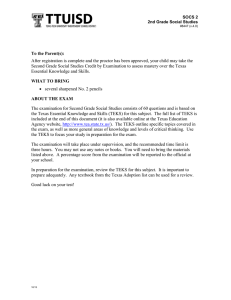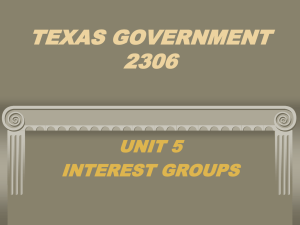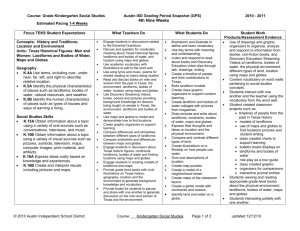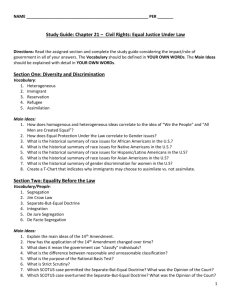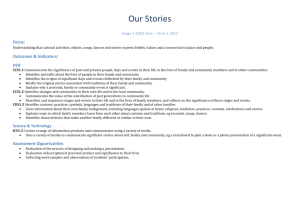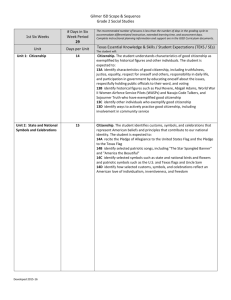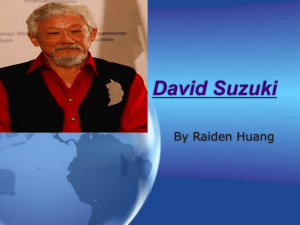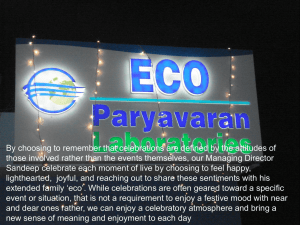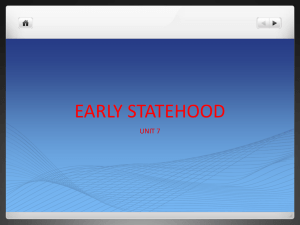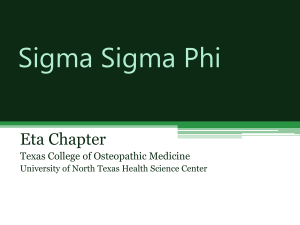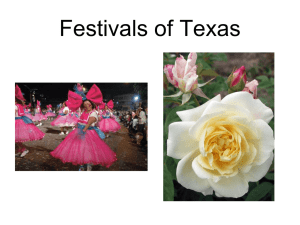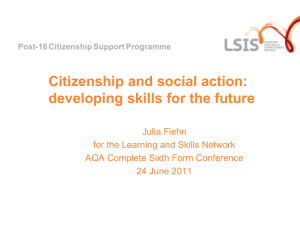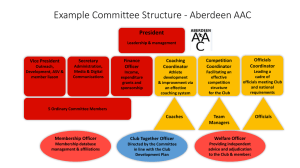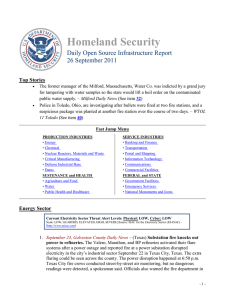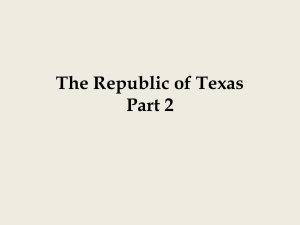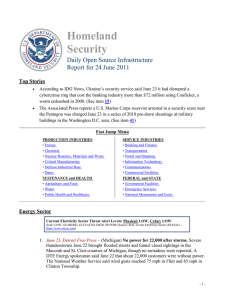Document
advertisement
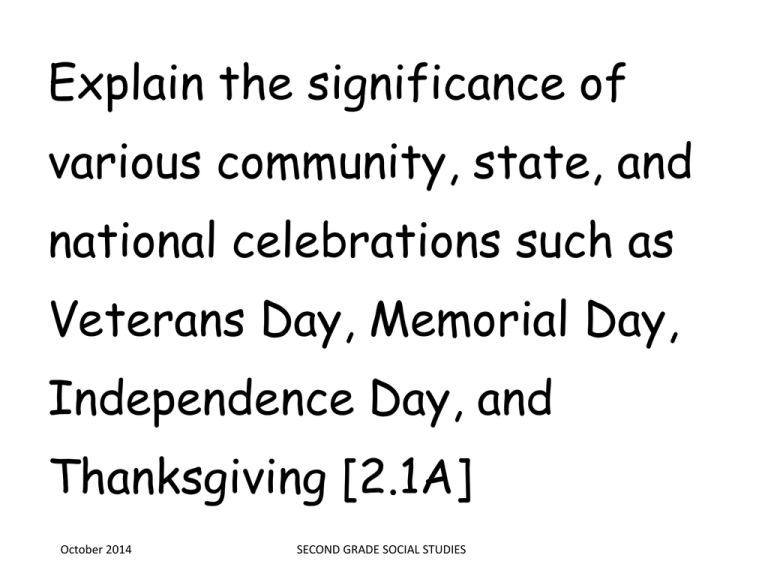
Explain the significance of various community, state, and national celebrations such as Veterans Day, Memorial Day, Independence Day, and Thanksgiving [2.1A] October 2014 SECOND GRADE SOCIAL STUDIES identify and explain the significance of various community, state, and national landmarks such as monuments and government buildings.[2.1B] October 2014 SECOND GRADE SOCIAL STUDIES describe the order of events by using designations of time periods such as historical and present times.[2.2A] October 2014 SECOND GRADE SOCIAL STUDIES apply vocabulary related to chronology, including past, present, and future.[2.2B] October 2014 SECOND GRADE SOCIAL STUDIES create and interpret timelines for events in the past and present.[2.2C] October 2014 SECOND GRADE SOCIAL STUDIES identify several sources of information about a given period or event such as reference materials, biographies, newspapers, and electronic sources.[2.3A] October 2014 SECOND GRADE SOCIAL STUDIES describe various evidence of the same time period using primary sources such as photographs, journals, and interviews.[2.3B] October 2014 SECOND GRADE SOCIAL STUDIES identify contributions of historical figures, including Thurgood Marshall, Irma Rangel, John Hancock, and Theodore Roosevelt, who have influenced the community, state, and nation.[2.4A] October 2014 SECOND GRADE SOCIAL STUDIES identify historical figures such as Amelia Earhart, W. E. B. DuBois, Robert Fulton, and George Washington Carver who have exhibited individualism and inventiveness.[2.4B] October 2014 SECOND GRADE SOCIAL STUDIES explain how people and events have influenced local community history.[2.4C] October 2014 SECOND GRADE SOCIAL STUDIES interpret information on maps and globes using basic map elements such as title, orientation (north, south, east, west), and legend / map keys.[2.5A] October 2014 SECOND GRADE SOCIAL STUDIES create maps to show places and routes within the home, school, and community.[2.5B] October 2014 SECOND GRADE SOCIAL STUDIES identify major landforms and bodies of water, including each of the continents and each of the oceans, on maps and globes.[2.6A] October 2014 SECOND GRADE SOCIAL STUDIES locate places of significance, including the local community, Texas, the state capital, the U.S. capital, major cities in Texas, the coast of Texas, Canada, Mexico, and the United States on maps and globes.[2.6B] October 2014 SECOND GRADE SOCIAL STUDIES examine information from various sources about places and regions.[2.6C] October 2014 SECOND GRADE SOCIAL STUDIES describe how weather patterns and seasonal patterns affect activities and settlement patterns.[2.7A] October 2014 SECOND GRADE SOCIAL STUDIES describe how natural resources and natural hazards affect activities and settlement patterns.[2.7B] October 2014 SECOND GRADE SOCIAL STUDIES explain how people depend on the physical environment and natural resources to meet basic needs.[2.7C] October 2014 SECOND GRADE SOCIAL STUDIES identify the characteristics of different communities, including urban, suburban, and rural, and how they affect activities and settlement patterns.[2.7D] October 2014 SECOND GRADE SOCIAL STUDIES identify ways in which people have modified the physical environment such as building roads, clearing land for urban development and agricultural use, and drilling for oil.[2.8A] October 2014 SECOND GRADE SOCIAL STUDIES identify positive and negative consequences of human modification of the physical environment such as the use of irrigation to improve crop yields.[2.8B] October 2014 SECOND GRADE SOCIAL STUDIES identify ways people can conserve and replenish natural resources.[2.8C] October 2014 SECOND GRADE SOCIAL STUDIES explain how work provides income to purchase goods and services.[2.9A] October 2014 SECOND GRADE SOCIAL STUDIES explain the choices people in the U.S. free enterprise system can make about earning, spending, and saving money and where to live and work.[2.9B] October 2014 SECOND GRADE SOCIAL STUDIES distinguish between producing and consuming.[2.10A] October 2014 SECOND GRADE SOCIAL STUDIES identify ways in which people are both producers and consumers.[2.10B] October 2014 SECOND GRADE SOCIAL STUDIES examine the development of a product from a natural resource to a finished product.[2.10C] October 2014 SECOND GRADE SOCIAL STUDIES identify functions of governments such as establishing order, providing security, and managing conflict.[2.11A] October 2014 SECOND GRADE SOCIAL STUDIES identify governmental services in the community such as police and fire protection, libraries, schools, and parks and explain their value to the community.[2.11B] October 2014 SECOND GRADE SOCIAL STUDIES describe how governments tax citizens to pay for services.[2.11C] October 2014 SECOND GRADE SOCIAL STUDIES name current public officials, including mayor, governor, and president.[2.12A] October 2014 SECOND GRADE SOCIAL STUDIES compare the roles of public officials, including mayor, governor, and president.[2.12B] October 2014 SECOND GRADE SOCIAL STUDIES identify ways that public officials are selected, including election and appointment to office.[2.12C] October 2014 SECOND GRADE SOCIAL STUDIES identify how citizens participate in their own governance through staying informed of what public officials are doing, providing input to them, and volunteering to participate in government functions.[2.12D] October 2014 SECOND GRADE SOCIAL STUDIES identify characteristics of good citizenship, including truthfulness, justice, equality, respect for oneself and others, responsibility in daily life, and participation in government by educating oneself about the issues, respectfully holding public officials to their word, and voting.[2.13A] October 2014 SECOND GRADE SOCIAL STUDIES identify historical figures such as Paul Revere, Abigail Adams, World War II Women Airforce Service Pilots (WASPs) and Navajo Code Talkers, and Sojourner Truth who have exemplified good citizenship.[2.13B] October 2014 SECOND GRADE SOCIAL STUDIES identify other individuals who exemplify good citizenship.[2.13C] October 2014 SECOND GRADE SOCIAL STUDIES identify ways to actively practice good citizenship, including involvement in community service.[2.13D] October 2014 SECOND GRADE SOCIAL STUDIES recite the Pledge of Allegiance to the United States Flag and the Pledge to the Texas Flag.[2.14A] October 2014 SECOND GRADE SOCIAL STUDIES identify selected patriotic songs, including "The Star Spangled Banner" and "America the Beautiful".[2.14B] October 2014 SECOND GRADE SOCIAL STUDIES identify selected symbols such as state and national birds and flowers and patriotic symbols such as the U.S. and Texas flags and Uncle Sam.[2.14C] October 2014 SECOND GRADE SOCIAL STUDIES identify how selected customs, symbols, and celebrations reflect an American love of individualism, inventiveness, and freedom.[2.14D] October 2014 SECOND GRADE SOCIAL STUDIES identify selected stories, poems, statues, paintings, and other examples of the local cultural heritage.[2.15A] October 2014 SECOND GRADE SOCIAL STUDIES explain the significance of selected stories, poems, statues, paintings, and other examples of the local cultural heritage.[2.15B] October 2014 SECOND GRADE SOCIAL STUDIES identify the significance of various ethnic and / or cultural celebrations.[2.16A] October 2014 SECOND GRADE SOCIAL STUDIES compare ethnic and / or cultural celebrations.[2.16B] October 2014 SECOND GRADE SOCIAL STUDIES describe how science and technology change communication, transportation, and recreation. [2.17A] October 2014 SECOND GRADE SOCIAL STUDIES explain how science and technology change the ways in which people meet basic needs. [2.17B] October 2014 SECOND GRADE SOCIAL STUDIES



